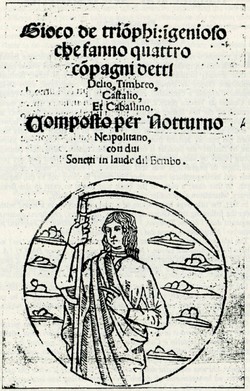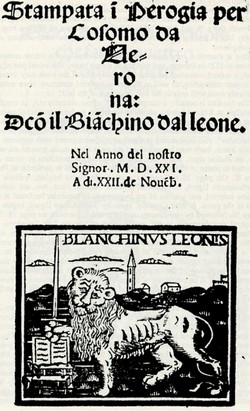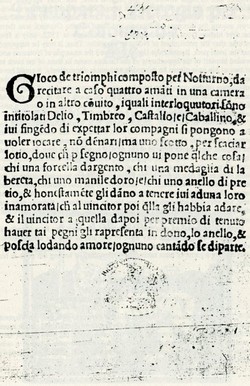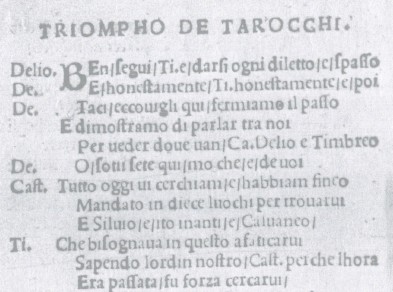Notturno’s Gioco di Triomphi
by Franco Pratesi, 1988
(from: The Playing-Card, XVII, No. 1, 23-33)
|
The evidence presented in this article derives from a scarce booklet which existed in the 18th century in Capponi’s library and whose reported title already indicates its interest for the history of tarot: Notturno Napolitano "Gioco de trionfi, che fanno quattro compagni, detti Delio, Timbreo, Castalio, e Caballino, con due sonetti in laude del Bembo". Perugia per Cosmo da Verona detto il Bianchino s.a.(1). Therefore, it did not escape attention by the few Italian scholars who seriously attempted to collect and discuss the literary evidence about the game.(2) Both Cian and Renier, however, could not examine a copy of the book, due to its rarity, and only mentioned the title as derived from the Capponi catalogue. Also in the known work by Sander(3) the booklet is only mentioned, under Caracciolo Antonio, among others by same author and printer, with the statement that any presence there of engravings was still unknown. Nowadays, more catalogues exist, and bibliographical researches are easier to carry out to the required depth. In this case, a copy of the book was found to exist in the British Library, wherefrom a microfilm copy was obtained for study.
If I am allowed to summarize the summary, four fellows are playing tarot while awaiting other friends, not for money but for some valuable thing they had with them. A girl friend holds the pledges and one of them, a ring, is finally left to her by the winner. Then everybody goes away singing and praising love. One is therefore very curious to know the details of a whole comedy, printed in 1521 in Perugia, and devoted to a tarot game. The initial part of the work is indeed concerned with tarot. The very title of the book may, however, appear misleading, as well as the above reported summary, since tarot is explicitly dealt with only in the first few pages of the text. The booklet is actually a composite work whose contents may be roughly described as follows (giving successive numbers to the unnumbered pages). First the Comedy by Notturno is reported, which gives its name to the booklet. Apart from the rather common story of shepherds and nymphs, several "interludes", also represented in the open air, are inserted with apparent didactic intent. Such may be considered the parts on tarot, on general astronomy, on Zodiac signs, and so on; similar inserted compositions in verses are devoted to praise of Florence, of the Medici family, and in particular of Pope Leo X. On page 38 a “Comedia overo Tragedia” begins, written by Bartholomeo Ugoni, of the same pastoral content. Here, too, are several poems inserted, and a series of ten sonnets can in particular be found at the end of the piece. A third “Comedia”, again by Bartholomeo Ugoni, begins on page 56, followed by two “canzoni”, until the end of the book on page 78. The general environment is the small town of Borgo San Sepolcro, or Sansepolcro, usually known as the birthplace of Piero della Francesca, now in the administrative boundaries of Arezzo, but under Florentine government for a few decades at the time of the work. Perugia only happens to be the nearest printing center, and Bianchino dal Leone was already active there, from the beginning of the century, mainly in the field of popular literature. Ugoni himself is an inhabitant of Borgo San Sepolcro, his praises are in several places devoted to the bishop of the town, Galeotto Graziano, as well as to Florence and the Medici. In several histories of Italian literature(4) Notturno is said to have travelled very much through most European countries, although little is really known on his actual life. Most historians associate his name with Antonio Caracciolo; he should have been mostly an extemporaneous poet, accustomed to declaim his verses both in noble courts and in market places. Now, a greater number of his works are known to us than to the historians of Italian literature of the past. During the second half of the 1510s, he published several short poems in Milan and in other towns of Lombardy, and two collections of his most representative works. Then, about twenty booklets, mainly four leaves ones of popular character, were published in the 1520s in Perugia by Bianchino dal Leone. Other works or reprints then appeared in Bologna, Venice, and in other towns. In the present case, one may suppose that Notturno once got up a performance in Borgo San Sepolcro, perhaps in honour of the new bishop. It may be recalled that Leo X had recently inserted the town among the dioceses of Tuscany and that Galeotto Graziani was there the first bishop from November 1520(5) to his death in 1522, only a few months after the publication of Notturno’s booklet. Thus, it may be supposed that the local poet, Bartolomeo Ugoni, followed the example of Notturno and availed himself of the opportunity of the famous name in front of the book to let two of his own pieces be printed in sequence; alternatively, it could have been Notturno, well acquainted with the printer in Perugia, to support the publication of this composite booklet, with a greater number of pages than usual. From the literary point of view, it may be noted how in some parts of the works a different kind of language is used for different characters: a procedure later to become routine. Our interest is, however, limited to the first work, that composed by Notturno under the above mentioned title. Moreover, the whole content of pastoral poetry has obviously lost all interest for the present reader, as have the frequent digressions in praise of the men of power of the time. Some of the digressions may be useful, however, to let us better understand the short preliminary part on tarot; an educational aim can indeed be found in several parts, such as the description of the Zodiac signs, the connected outline of essential astronomic knowledge, the discussion of the four elements and human nature. They are generally quite complete and detailed. From this point of view, the very first scene on tarot may also be considered a didactic text: the triumphs are individually described during play and their order discussed and justified. But let us consider the play in some detail. Even the proposal to play tarot may be of interest. The four friends sit down in the open air, while they have to rest and to wait for other friends. After proposals of telling jokes, of singing melodies about love, Castalio suggests to play a game of tarot taking the opportunity of having the pack in his pursue: «Tacete i’ n’ho trovato una più bella Vo che faciamo de triomphi un gioco Ch’io gli ho qui appunto meco in la scarsella.» Now, it is not very plausible to bring along in the pursue a pack of the Visconti kind and to suggest to use it out of doors; evidently something much more common had meanwhile resulted. On the other hand, the pack is still very beautiful since the friends appreciate it; one of them asks whether it was made there and Castalio answers that he let the pack be brought expressly from Spain: «..... D. Come en begli! T. Son fatti qui? C. appunto i fei portare Fin di la Spagna. ....» After the agreement only to use as stakes those valuable things recorded in the summary, the four friends also agree to play a single game. They draw lots for dealing, cards are shuffled and Delio deals. Each card is briefly commented on in the performance. In particular several discussions arise on the order of capturing among cards which appear equally powerful if compared to the actual personages or qualities they represent. The pros and cons are evaluated for each card being higher or lower with respect to the previous one, but at last the order of card sorting is agreed to be in ascending sequence: each card is taken by the following, so that the fourth to play wins that hand and plays the first card for the following one. No indication is provided whether other cards could be present before, or in between, with respect to those actually played. Unfortunately, several problems arise in the analysis of the text on tarot. The main problem is how much the illustrative example of play may be considered complete and realistic. In particular, the first question is whether the 56 numeral and court cards - never mentioned here - were actually present in the pack. If one takes the general accuracy of the quoted examples into consideration, the hypothesis appears more plausible that the whole pack consisted here in the 22 triumphs. In fact, in literary references to the tarot pack, coming from the times of the Italian Renaissance, the 22 triumphs are sometimes quoted without any mention of the remaining cards of the pack. Whenever the authors explicitly take into account the problem of the composite character of the pack (for instance, in the relevant works by Aretino and Speroni,) it is, however, stated that the pack may be used either as a whole, or without the triumphs cards. Nowhere, to my knowledge, is a game explicitly described which is only based on the 22 triumphs, so that - when a game is outlined - the ‘remaining’ 56 cards may be assumed to be present in the pack even if they are not mentioned. An exception to the above statement may be considered - although that 'game' is of a very particular kind - the text by Teofilo Folengo in “Caos del Triperuno”, which I intend to comment on in a next article. Here, however, we are probably in the presence of a 22-card pack of triumphs, as in the case of Folengo’s sonnets. However unusual that pack may appear, it is here used in the usual play: lots are drawn for dealing, cards are dealt to each of the four players, cards are then played and tricks won in the ordinary way. There can be no doubt that tarot existed in several variants. For instance to play it “alla Toscana” or “alla Villotta” are mentioned some years later in Lollio’s manuscript preserved in Ferrara. Although nowhere can explicit indications be found on it being played with the 22 triumphs only, several hints may be detected in Renaissance literature. Among the possible candidates for such a role, Scartino can be mentioned, which was so familiar and so much appreciated by Isabella d’Este and other court personages particularly in Mantova and Ferrara (6). For four players five cards are dealt to each and the two remaining form the scarto and the diminutive name comes to mind, precisely due to the limited extent of the pack. Cardano's Sequentinus taroccus may be another, Ludus fulcinellorum and the Gioco delle venti figure may represent further possibilities. However, the most immediate attribution among all of them is to put that pack in correspondence to Trionfetti, as I am suggesting in a next article on the basis of new evidence from Venice. The pack of 22 cards may be found to be too small for a game of skill, particularly for no less than four players. It may be considered, however, that the game was introduced in a time when simple dice games flourished as well as boardgames of the morris kind, most of which became games only for children in later centuries. And, if the game was indeed found to be too simple, a more reasonable way to increase the number of the triumphs can be supposed to lead to Minchiate: rather than changing the pack from 78 cards to 97 the modification, if any happened in this way, more plausibly could occur from a 22 to a 41 triumphs pack. Leaving, at least for the moment, the field of suppositions, some comment can be devoted to various statements in the text. Highly surprising, for instance, is the suggested origin, already mentioned, of the pack from Spain, since we know that precisely that country was virtually uninfluenced by any tarot fashion in past centuries. A possible reason for justifying that mention may be found in a diffusion of the renown of "triumphus hispanicus", the well known Spanish game, sometimes considered as the card game 'par excellence'.(7) An important quotation corresponds to the heading of the initial part of the comedy as triompho de tarocchi. Those two relevant words are here used in a peculiar sense: 'triomfo' as commonly for celebration, 'tarocchi' apparently for the triumphal cards. That is not absolutely the first time that the word appears, since it has been found documented five years earlier in Ferrara; however, it is the first time that the word appears in a printed text, as far as I know, preceding by another similar time interval the often quoted mention by Bemi. Less surprising is the order of the triumphs, although it does not exactly correspond to any of those already known. Luckily, the cards are apparently illustrated as played not in a chance order but following a regularly ordered succession, so that it seems possible to draw some deductions from their order; unfortunately, the text does not cover the whole series of the triumphs, and about one half of them are not mentioned here. It seems that imperatore and papa are the only two cards of their role; the corresponding "wives" are nowhere mentioned. Pope is stated, and agreed after a short discussion, to be higher. Speaking then of the Fool, it is admitted to be higher than any Emperor, Pope, or Cardinal. This may be a hint to a Cardinal card present in this pack, such as mentioned in other cases or directly shown in some ancient pack. It is, however, more probable that the mention here is only applied to the social environment, without any direct reference to card symbols. It is important for the question of the origin of its peculiar role in the game that matto does not have here its usual meaning of free card; on the contrary, it appears as a low card in the sequence, intermediate between the mentioned personages and the bagatella. Before this evidence, the Fool could indeed be supposed to have been directly introduced into the game with its known role of free card, out of the ordinary sequence. The following quartet of orderly played cards is composed by fortezza, temperanza, giustizia, and carro. Thus we find the three virtues together in a low position (i.e., without Justice being promoted to a very high location connected to the Final Judgment, as it occurred in Ferrarese Tarot, or Temperance shifted above Death, probably in order to maintain number 13 to the last figure, as it occurred in Milan - B and C Dummett's orders, respectively.) Although we don't obtain an agreement in detail, a more similar sequence can be found in Dummett's A order, which seems to correspond to a more logical arrangement of the triumphs than the remaining ones (for instance, precisely due to the position of the virtues in the sequence). As known, it was preserved in following centuries only in Minchiate, Tarocchino Bolognese, and Siciliano, and a few other cases. The third quartet of cards then begins with rota and vecchio, but unfortunately the straightforward illustration of the series comes here, more or less abruptly, to an end, just before considering the "unpleasant" cards, such as Death, Devil, and Tower. Perhaps they were considered to be unsuitable to the stage. Whatever be the reason, Notturno does not complete his description of the tarot pack, to which the title and the preliminary introduction to the piece were fully devoted. Or, at least, he does not complete it directly; in fact, the author does not explicitly mention tarot again in the following thirty pages of the text. However, it may be supposed that tarot was still present later on in the comedy: not common tarot, but Minchiate. In particular, it is impossible not to think of Minchiate, since the work originated in a place under Florentine ruling; moreover, the title and the introductory part indicate a presence of tarot in the performance greater than derived from the first few pages of the text. Thus, it is well known how the Zodiac signs are a considerable and characteristic part of Florentine tarot. It does not seem by chance that precisely their images are found in a booklet that a nymph is reading and explaining during the performance, even quoting the number of stars for each constellation. Similarly, it does not appear by chance if a description is inserted, later on in the comedy, of the four elements and their relevance to human nature. These elements - air, water, earth, fire - also represent a group of specifically Minchiate cards. This supposition may be accepted or not, since there are no explicit references; however, even if the introduction of Minchiate is still considered to have occurred more recently, the present text, dealing together with tarot, zodiac signs, and the four elements, appears to be related with Minchiate formation or at least with the cultural environment of their origin. Unfortunately, even if one is persuaded, as I am, that indeed Minchiate are somehow hinted in other parts of the comedy, the information to be gained from these further descriptions is not very useful to us. No further hint is provided either to the rules of play, or to the problem of the initial order of the tarot. In particular it remains uncertain whether the pack was merely used under the shape of a triumph-only-pack. Certainly, a pack of 41 triumphs appears more suitable to card play than a 22-triumphs one; it may be sufficient to remember that a 40 card pack is, since centuries, the most used by Italian peoples. If it occurred as such, its use can be perhaps considered as a stratagem to avoid prohibitions or, else, as the maintenance of even older traditions. In any case, the possibility exists that, no later than 1521, a Minchiate pack was described to the inhabitants of Borgo San Sepolcro - certainly not a big town - and it was shown in the hands of common people. This being the case, one has to assume that the introduction of Minchiate occurred somewhat earlier than stated in the recent histories of cards. In particular, also the document by Pulci reporting Lorenzo de’ Medici playing Minchiate may there from acquire a significant support. Several hypotheses have been proposed above, concerning the cards described in the text; finally, it may be useful to come back again to the mere evidence. In the initial part of the comedy ten cards are described and a discussion is provided as their exact order for winning tricks, which is acknow ledged to be the following: 1. Imperatore, 2. Papa, 3. Matto, 4. Bagatella, 5. Fortezza, 6. Temperanza, 7. Giustizia, 8. Carro, 9. Rota, 10. Vecchio. What about those cards representing an original first set of triumphs? Similar ideas have been recently suggested on the basis of the odd composition of the first tarot pack known, the Visconti de Modrone’s one, and on the basis of the lacking cards (absolutely or in the supposed original composition) in the following Visconti’s packs(8). I have to admit my unpreparedness to critically evaluate such suggestions. Obviously, the beginning of Notturno’s series appears very promising, since Emperor and Pope can be considered as a logical continuation of the court cards, entering a new domain of super-cards. But, what for the Fool and the Juggler after them? Independently from the alleged reasons, they appear rather in this case as resulting from a retrieval of forgotten items coming from a pre-existing series. Then we have the fortunate occurrence of three Virtues together (we would only have wanted the fourth one to be present too). Finally, the Chariot, the Wheel, and the Aged Man. It seems to be that this small group is already odd enough; i.e. if this were the initial seed, the whole of the 22 triumphs is not needed for justifying the oddity found in the logical meaning of the sequence. Moreover, apart from the absence of the 'astronomical' and 'infernal' cards, a detailed agreement between Notturno's sequence and the extant Visconti di Modrone's cards (as well as for the suggested Visconti original ones) does not seem to exist. I apologise for any superfluous consideration in the discussion above; it is to be hoped that some specialist of tarot history can soon find the clues in the whole problem. In conclusion, the 'new' evidence deriving from Notturno's comedy appears to be far from complete and unambiguous. It provides, however, the first description ever of a tarot game, it mentions the name itself of 'tarocchi', it lists in order no less than 10 triumphs; in any case, here all of these details appear for the first time in a printed text! To get nearer to the very origin of tarot will be very difficult by that way; it will probably be necessary to find out forgotten handwritten documents, which are still more difficult to rediscover. (1) Thus it was registered in “Catalogo della Libreria Capponi” Roma 1742, p. 272. |
|



